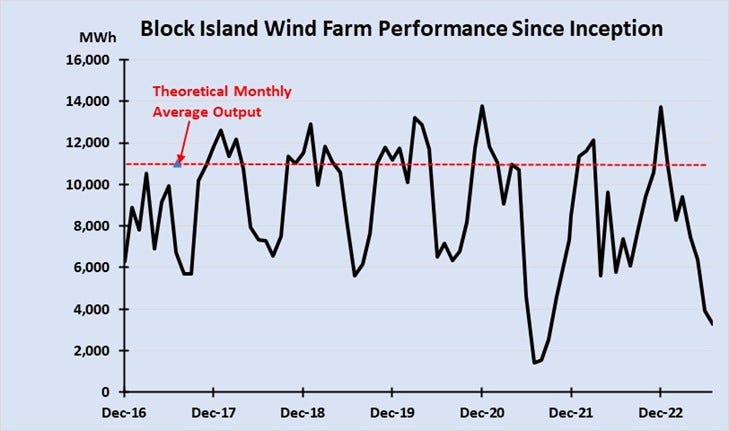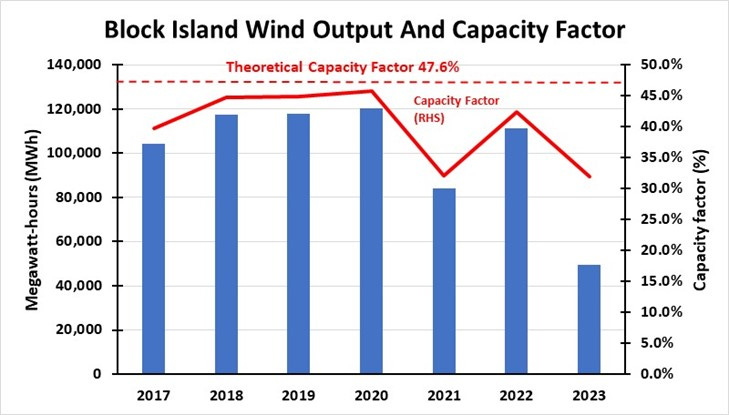Energy Musings - October 12, 2023
We finally got the April output data from Block Island Wind and an explanation for why it is not on the EIA's website. BIW continues to under-perform just as we wrote in our earlier posting.
Updated BIW Output Data And Charts
We recently wrote one of our periodic updates on the performance of the nation’s first and largest offshore wind farm – Block Island Wind – off the Rhode Island coast. At the time of our article, we noted that there was no data for April posted on the Energy Information Administration’s website for specific electricity plant outputs. We contacted Ørsted, the owner and operator of the wind farm inquiring about the missing data.
After nearly two weeks of waiting, we again contacted Ørsted who apologized for failing to get back to us as promised in our initial email contact. They provided the April output data and explained that they had routinely supplied the information to the EIA but there seemed to be a “technical issue with the portal” and that they had been in contact with the agency. It seems surprising that there was an issue, and that the EIA has not responded or corrected it after all these months.
For April, BIW produced 7,446 megawatt-hours of electricity. That was better than the wind farm generated in either April 2022 or April 2017, but woefully below the April monthly outputs of the intervening years. Compared to the lowest monthly output of those other Aprils, 2023 trailed by 3,400 MWh. Against the best April month, this April trailed by 5,400 MWh.
We have updated our spreadsheet and charts. For the first seven months of 2023, BIW has generated 49,521 MWh of electricity. That represents 32% of the theoretical capacity output for that period. The monthly capacity output is calculated by dividing the annual total capacity output by 12 to get a monthly average and then multiplying that amount by seven for the period.
Deepwater Wind officials, the original developer of BIW and a subsidiary of hedge fund DE Shaw, repeated statements made by wind turbine supplier General Electric Renewable Energy in its various press releases. In March 2016, as the project was underway, Deepwater Wind hosted Rhode Island’s then-governor, Gina Raimondo, and GE officials in a ceremony marking the progress of the project to construct the nation’s first offshore wind farm off Block Island. In GE’s press release announcing the ceremony, the company wrote:
Led by Deepwater Wind, the Block Island wind farm will use five 6-MW GE “Haliade” turbines to generate 30 MW of power, enough to produce around 125,000 MWh of electricity, thus meeting approximately 90% of Block Island’s electricity demand.
Because BIW has never achieved the targeted output (see the charts below), Ørsted with the help of a compliant Rhode Island media has attempted to rewrite the performance capability of the wind farm. Now, BIW is supposed to produce 100,000 MWh of annual output. When we questioned the Providence Journal reporter about his using a lower annual output total given the GE and Deepwater Wind statements, we were told that his number was what was generally expected from the wind farm at the time. Of course, the lower output enabled the reporter to write a glowing article about how well BIW is doing, only failing to meet the reduced target in 2021, the year extensive maintenance was undertaken because of the discovery of cracks in the wind turbines.
Under GE’s pledge for wind turbine output, BIW has never met it. The reduced expectation is a convenient way for Ørsted to claim how well BIW is performing. That also ignores the extensive repairs, including having to completely disassemble one nacelle to replace the coils. This is after the wind turbines operated for less than six years of their 25-30-year life. Because BIW is owned by a limited liability subsidiary of Ørsted, we have no idea how well or poorly the wind farm is performing financially.
The following chart shows the monthly output of BIW compared to its monthly theoretical output. Yes, the wind blows strongest in the winter months, which is when the power is most in demand given the supply challenges the New England power grid faces when it loses access to substantial supplies of natural gas, the primary fuel generating electricity for the system. That gas supply is shifted to home heating, which is not needed during the rest of the year when wind output is less needed.
The April 2023 data showed BIW out-performed the same month in 2017 and 2022, but trailed every other April.
Here is the record of BIW annually against its theoretical annual output per GE and Deepwater Wind.
Seven months of BIW output data still leaves the wind farm significantly under-performing the past years, signally a continuation of disappointing performance.
The real-world performance of BIW should be kept in mind when evaluating the claims about offshore wind farms planned and under construction.





